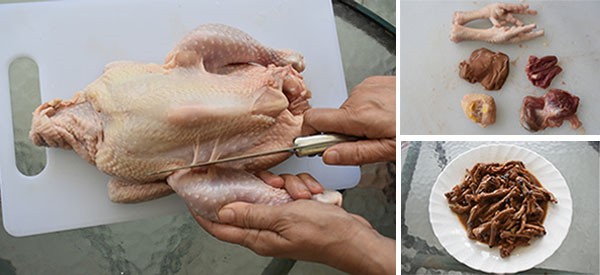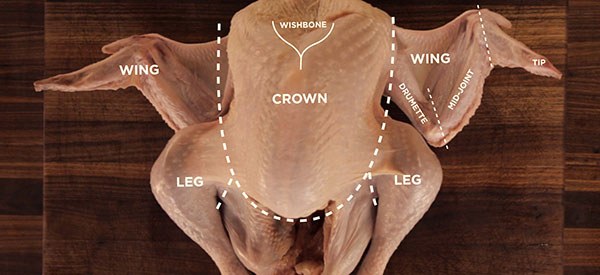I've thought about getting a cone, but haven't yet. Here is how I have always done it:
I pound two 16p nails into a stump or chunk of wood just far enough apart to get a chicken's neck between them, but too close together for the head to pass through (an inch to an inch and a half -- check your chickens, because it will depend on breed).
Catch the chickens you want to butcher the night before and keep them in a box or crate overnight (catching them while they are on the roost is much easier on both you and them than chasing them all over the place). They should have water but no food.
Before starting to butcher, I assemble my equipment and start a large kettle of water heating -- you want it just below a simmer, too hot to keep your hand in very long. Equipment includes a sharp hatchet or axe or machete for chopping heads off; the stump or wood with the nails in it; a sturdy hook in a wall or a tree branch to hang the chickens from while they bleed and some cord, wire, or baling twine to hang it with; a 5 gallon bucket; a large bowl or clean bucket of cold water (put some ice cubes in it if you can); a smaller bowl for the giblets; a sharp knife and/or pair of kitchen shears; pliers; a work surface (boards over a sawhorse, or some washable table surface you can set up outdoors) covered with a piece of plastic; a large garbage bag attached to said work surface in such a way it stays open -- a wire loop helps -- to collect the feathers, unless you don't mind them ending up all over the yard; whatever you are going to package the meat in (freezer bags, freezer paper, etc.). Keep a hose handy for clean-up as needed.
When the water is hot enough (not boiling), put a couple of drops of dish detergent in it.
Take your first chicken, hold it upside down by it's feet for a minute, until it calms down, then lay it down with the neck on the two nails and push the neck down between the two nails so the chicken is stuck there (holding onto the feet all the time, of course). Still holding the feet, pull back so the neck is stretched, and chop it through near the head with your hatchet, axe, or machete. Immediately drop the chicken into the empty bucket so it doesn't flop all over the yard. The head can go into the garbage bag.
Once the dead chicken has mostly stopped flopping, take it out of the bucket and hang it up to finish bleeding. While it bleeds out, chop the head off of another one. (With as many as seven people helping, three of them adults, we've done 100 Cornish X in one weekend without any other equipment than what I've mentioned. However, by myself, with a bad back, I prefer to butcher no more than 3-5 at a time. If you have a bunch and you are spacing them out, weigh them and butcher the largest first, so the others can put on some more weight.)
It helps to line things up in order of operation, so you go from crate of chickens to kill location to bucket to hanging to scalding pot to table for plucking to butchering to house for freezing.
When one chicken has finished bleeding (should only take a few minutes), holding it by the feet, dunk it in the scalding pot and swish it around for a minute. Test by pulling on a few body feathers to see if they are ready to come out easily but don't pull chunks of skin with them. (Chunks of skin means the chicken stayed in too long.) After some experience it gets easier to judge the right amount of time in the scalding pot -- don't worry about it if your first few aren't perfect.
Immediately start plucking. In my experience, if the scalding is done properly, you can just about sweep most of the feathers off with a few swipes from your hand. But the large wing feathers will need to be pulled with pliers, or you can just cut off that portion of the wing as there isn't much meat there anyway. There will always be a few other feathers that need the pliers, such as on the tail, and you may want to use an open flame to burn (carefully) the pin feathers off.
Once the plucking is done, the next step requires your sharp knife or kitchen shears -- I trim up the bloody end of the neck, then cut the body cavity open, trimming around the vent and trying not to cut the insides so as to get poop all over the meat. This part is hard for the squeamish, but next you need to put your hand inside the body cavity and scoop all of the innards out. Make sure to get the lungs, which are attached in between the ribs under the back of the chicken. You'll have to break the diaphragm to get the heart. And you'll need to use some strength to pull the trachea through and out with the rest of the innards -- it can help to go ahead and chop the neck off first.
Take the heart, gizzard (which will need to be opened and cleaned later), and the liver (carefully remove the gall bladder with your knife or scissors without breaking it), and set them aside in the giblet bowl. (If the gall bladder does break, just remove the meat that the green liquid touched, as it will be very bitter.) Cleaning the gizzard is pretty easy -- if you think of it as a pillow shape, cut it open around three sides of the pillow edges. Wash away the grit and food residue inside (your sink will thank you if you don't do this in the house); then peel the thick membrane that was on the inside of the gizzard and discard it. It takes a bit of strength but comes off fairly easily.
Rinse the chicken carcass, look it over for pin feathers one more time, and drop it into the ice water until you are finished with all of them. Then you can package them up and put them away. I like to cook the giblets the same day, usually -- we'll have fried chicken livers for lunch or supper, and let the hearts and gizzards simmer on low for hours to make a good chicken soup base.
Then you just need to clean up the mess, wash the blood off your tools and the chopping block, put everything away, and you are done!
The first time will be the hardest, especially if you've never done any kind of butchering before, but it does get easier with practice. For me, the key is making sure I have my assembly line in place, all my equipment ready, and am ready to go before starting. It makes things go pretty quickly.
Kathleen
ETA: Flies may be a nuisance while you are working, but yellowjackets can be a real problem. I haven't even seen a yellowjacket here in KY (though I'm assured they do have them here), but when we lived in the high desert in Eastern Oregon, I had to move my butchering operations indoors because the yellowjackets were so bad. If you have a similar problem, you may have to set up inside a garage or even in the house. In the house can be done (you would still kill and hang the birds outdoors), you'll just want to be really careful about catching all the feathers in the garbage bag.


 What a circus that would be!
What a circus that would be!
